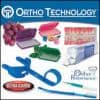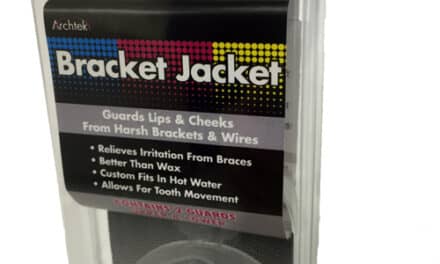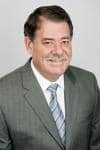by Ed Lin, DDS, MS
Taking 21st-century orthodontics into the 3D world
 |
As a 1999 graduate of the orthodontic residency program at Northwestern University Dental School, I have the unique distinction of being only one of six people able to lay claim to being in the last graduating class prior to the school’s most unfortunate closure. I have been in private practice in my hometown of Green Bay, Wis, for about 9 years, and it amazes me to look back and see the dramatic changes that have taken place in our profession in a relatively short period of time. The way I currently practice orthodontics in the 21st century bears little resemblance to the training that I received during my residency program. I was taught excellent fundamentals, however, and received a very solid foundation in clinical orthodontics. Because of this solid foundation, I have been able to expand upon my orthodontic mechanics, especially with the advances of cutting-edge technology.
After graduating from my orthodontic residency program, I had the good fortune of joining a very well-established practice in my hometown of Green Bay: Orthodontic Specialists of Green Bay (OSGB). OSGB also happens to be the practice where I had received my own orthodontic treatment in my late teens. When I joined OSGB in July 1999, our practice consisted of Rick Steinke, DDS; Michelle Koster, DDS, MS; Kevin Wilke, DDS, MS; and myself. Our practice now consists of Wilke; Iwei Huang, DDS, MS; Lee Bialkowski, DDS; and yours truly. We have two main practice locations in Green Bay and a 1-day-per-week satellite practice in Oconto Falls, Wis. We have a unique situation within our group practice, because we do not share patients. Practically speaking, we are four individual practices under one roof that share overhead expenses.
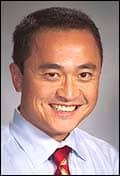 |
| Ed Lin, DDS, MS |
As newbie orthodontists, our main focus is on perfecting the clinical skills that we have learned in our orthodontic residency programs. Because of my good fortune in joining OSGB, I also had the opportunity to integrate technological changes that were taking place in our profession at a very early stage in my career. OSGB already had begun the transition into the digital age. Our practice had been an Orthotrac Classic practice for 2 years prior to my arrival and had just gone through training with Orthotrac Imaging in June 1999. I have always had an affinity for technology, and I was fascinated by the potential benefits that technology had to offer our profession and our patients. As a result, I have always searched out continuing education courses that had a technology focus.
One of the most important orthodontic meetings that I have ever attended was the 2002 Moyer’s Symposium called, “The Nuts and Bolts and Bits and Bytes in Contemporary Orthodontics.” It was at this meeting that I met Chester Wang, the president of Dolphin Imaging, and had the opportunity to hear him present for the first time. I was amazed at the benefits that Dolphin Imaging had to offer, and was especially impressed by its Virtual Treatment Outcome Module for orthognathic surgery. It was also at this meeting that I first heard David Hatcher, DDS, present and I first heard of cone beam computed tomography (CBCT). Little did I know, both of these technologies would have a significant impact on our practice in the very near future.
Management Software
In July 2002, our practice made a major decision and switched to Dolphin primarily because of the advantages that we saw with Dolphin’s imaging applications. A second major reason for the switch was our confidence in Dolphin Imaging as a pioneer that would stay at the forefront of orthodontic imaging. A third and final reason for the switch was because the team at Dolphin Imaging gave us confidence in the IT support that we would receive. It is my opinion that strong IT support is critical with any technology company that an orthodontic practice becomes involved with. The quality of support can make a major impact on how your clinical day flows when IT problems do arise—and they will. Combining Dolphin Imaging with digital radiography and digital photography was the start of our practice’s transition to establishing efficient digital systems.
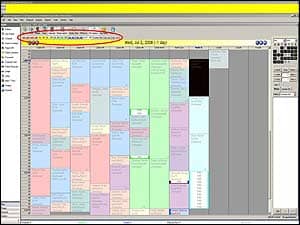 |
| Figure 1: Customized software allows us to schedule patients for each doctor and location. |
Our relationship with Dolphin Imaging over the years has been fantastic, and it was because of our strong relationship that we made another important decision: to switch to Dolphin Management in July 2004. Prior to our signing on with Dolphin Management, we met with its two main software developers to discuss our unique group practice situation. Since we do not share patients, we needed Dolphin to create the capabilities for us to schedule patients for each individual orthodontist at each practice location (Figure 1). Dolphin had to customize its management program for us, and it was able to do this in about 2 months’ time. Over the past 4 years, there have been several instances in which Dolphin customized its management program for us. I have always been impressed with its ability to do this, and I believe this is critical to the future management of our practice. We are becoming more and more of a customized society every day. Our computer desktops are customized; so are our iPods, cell phones, and laptops. Why should we not demand the same thing with something as important as our livelihood in our orthodontic practices? Because of the changing dynamics of our practice every year, we need a software management system that allows us to adapt to these changes quickly, and Dolphin Management provides us with the capabilities to do so.
Online Communications
With our practice’s transition toward a digital and paperless practice, we recognized another issue that we could improve upon: communication. As we all know, communication is a key element of any successful business. In November 2004, we incorporated Ortho Sesame™, a cool software program utilized for online communication purposes. This Web-based program gives our patients and referring dental practices the capability to access patient information through a secure online network without having to call our practice. Patient information includes such things as appointment times, billing information, digital photographs, and digital radiographs. This saves everyone time, because all the information is readily accessible at all times. We have had countless compliments from our patients over the past few years about how they love the fact that they can access the information they are looking for and not have to call during certain business hours or have to wait on the phone for someone to get them the information. This also reduces traffic for our receptionists and has allowed us to avoid having to add another receptionist.
Clinical Systems
As we all know, practice management is integral to the success of any practice. However, what is most important is the quality of care that we provide to our patients. A major technological decision that has tremendously impacted the quality of care that our practice has been able to provide was signing on with SureSmile® in February 2005. SureSmile is a technology that uses a combination of digital 3D scanning technology and computer-aided design (CAD) simulation with prescription, robotically bent Copper-Nickel-Titanium (Cu-Ni-Ti) archwires. SureSmile has given our practice better treatment results and a significantly decreased treatment time. We are actually treating our patients in the 3D world to the highest degree of accuracy and predictability, and there are no limitations with treatment because our patients are in treatment with full, fixed orthodontic appliances (Figures 2A–2G).
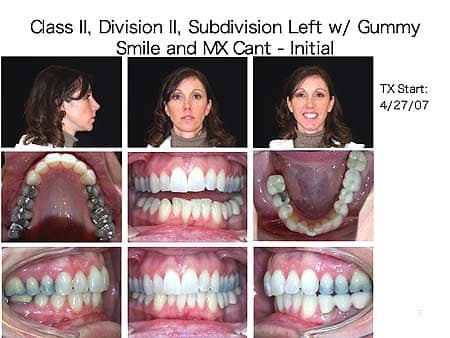 |
| Figure 2A: Initial records. Patient was treatment- planned for two-jaw orthognathic surgery but elected to pursue a nonsurgical alternative. |
 |
| Figure 2B: Two TADs were placed for maxillary cant correction in combination with a trans-palatal arch bar the same day as the full bonding. |
 |
| Figure 2C: Panorex generated from i-CAT in Dolphin 3D prior to placement of third TAD after distalization of the UL7 between UL6, UL7 for Class II correction. |
Using our SureSmile wires in combination with an interactive, self-ligating bracket system allows the prescription bends in the SureSmile Cu-Ni-Ti wires to be fully expressed in a very rapid fashion. Our practice uses the GAC Innovation-R and Innovation-C bracket system. These have proven to be very efficient and reliable systems for us, and save us considerable chair-time at our regular patient appointments. I am a firm believer in an interactive, self-ligating bracket system because I want the prescription bends of the SureSmile wires to be fully expressed. Our practice has been treating 100% of our patients with SureSmile since February 2008.
Patients in our practice love the fact that we are completing their orthodontic treatment with a significantly shorter treatment time with SureSmile. I love the fact that I know I am a better orthodontist today with SureSmile, because no matter how well I think I can bend archwires, I know that a computer and a robot can do it more accurately. Other industries in our society, such as medicine, airlines, automakers, and NASA, have embraced robotics. I personally believe that it is pretty cool that our esteemed profession of orthodontics has its own version of robotics as well.
 |
| Figure 2D: A third TAD placed between UL6, UL7 for Class II correction on the day of the SureSmile scan. |
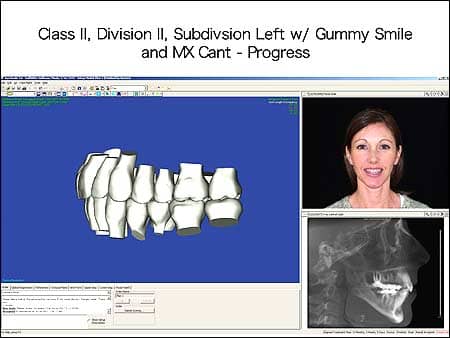 |
| Figure 2E: SureSmile plan demonstrating her correction to a Class I on her left side. |
My average treatment time for my SureSmile patients in 2007 was approximately 14 months. Decreased treatment time ultimately results in decreased hygiene risks for our patients. Other significant benefits with SureSmile are a decrease in overhead expenses due to the shorter treatment time—and also saving the time itself. We are a society that is driven by the philosophy that time is money. Decreased treatment time means a decrease in work and school issues for our patients. In this day and age, when gasoline expenses are a major topic covered in the media each and every day, decreased treatment time also means decreased travel expenses. It is my personal belief that SureSmile has become the standard of care in our orthodontic profession today.
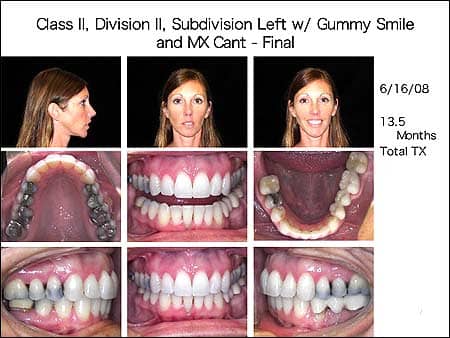 |
| Figure 2F: Final photos from the day she completed treatment in a total of 13.5 months. |
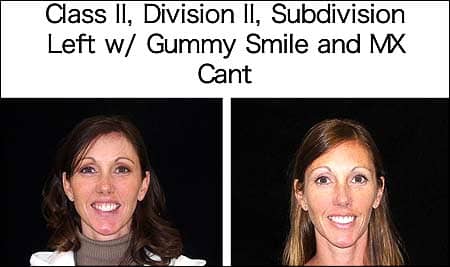 |
| Figure 2G: Pre- and post-treatment photos display correction of her maxillary cant and gummy smile. |
Imaging Advances
Two additional major technological advancements in our practice have been the addition of a CBCT machine, specifically the i-CAT® machine from Imaging Sciences, and Dolphin 3D, both of which we started using in September 2006. The i-CAT and Dolphin 3D have given our practice the capability to diagnose and treatment-plan with the highest degree of accuracy because we are able to see and evaluate things in 3D. Whereas conventional 2D radiographs could include distortion, elongation, and superimposition of the images, with 3D, there is no longer any guesswork in trying to evaluate things such as pathology (Figures 3A–3B). Evaluation of important clinical factors such as root resorption during the course of orthodontic treatment is a benefit as well (Figures 4A–4E).
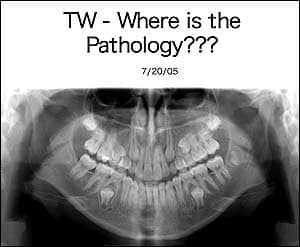 |
| Figure 3A: An Instrumentarium 2D digital panorex. |
 |
| Figure 3B: A 3D i-CAT panorex generated with Dolphin 3D makes evident a traumatic bone cyst in the same patient. |
If there has been one main negative for orthodontists during their considerations of using SureSmile, it has been the OraScan™. The OraScan has been classified as being difficult to learn and also as being uncomfortable for patients. Although this may be true in the initial stages of learning SureSmile, as with anything else, practice leads to perfection. Our practice has become very proficient with the scanning process, and scanning has not been an issue for our clinical assistants for the past 2 years. The average OraScan time in our practice is about 15 minutes. This time frame means that patient comfort is no longer a major factor.
That being said, another reason for our practice’s purchase of the i-CAT machine was that we had been in discussions with SureSmile about the possibility of using CBCT to help create the 3D SureSmile CAD simulation. In May 2007, our practice began a beta-test study with SureSmile for treatment of selected patients using CBCT scans to begin the process of creating the SureSmile wires. After initial beta-testing of 7 months with SureSmile and CBCT, the results were so fantastic that we began treating all of our patients who qualified with SureSmile and CBCT. Patients who qualify can be classified as patients with no large metal restorations (<4 mm in diameter) due to the concerns with scatter. This change in clinical protocol has led to approximately 80% of our patients being treated with SureSmile and CBCT.
The advantage of a CBCT scan over an OraScan is very clinically significant. The CBCT scan takes 20 seconds, versus approximately 15 minutes for an OraScan. This time savings has opened up a great deal of clinical time in our practice. Again, time is money, and this has essentially lowered our overhead expenses. Another significant advantage of CBCT and SureSmile is the fact that we can see the roots of the dentition. This ultimately leads to a more accurate and predictable SureSmile treatment plan for our patients, because we can see the entire crown and root anatomy of every single tooth. Most importantly, this leads to a higher level of therapeutic care for our patients (Figures 5A–5E; and Figures 6A–6D). Please note the hyperplastic tissue in both cases. Hygiene issues during the course of orthodontic treatment are a constant challenge for me with certain patients each and every day. I see significant hygiene benefits for all my patients because of the significant decrease in treatment time with SureSmile.
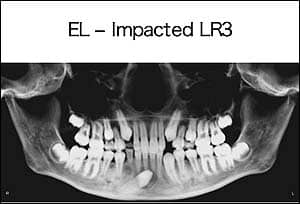 |
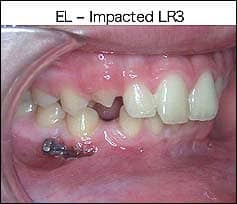 |
| Figure 4A: An i-CAT panorex generated with Dolphin 3D identifies a horizontally impacted right mandibular canine (LR3). | Figure 4B: A TAD serves as an anchor to upright and extrude the LR3 that had been surgically uncovered. |
 |
|
| Figure 4C: Comparison panorexes evaluating treatment progress with the uprighting and extrusion of the LR3 in only 6.5 months. | |
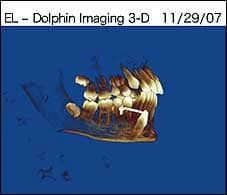 |
 |
| Figure 4D: Dolphin 3D Imaging allows orthodontists to evaluate potential root resorption of the adjacent incisors during the uprighting process. | Figure 4E: There has been no root resorption during the process of uprighting and extruding LR3 from both a right (4D) and left lateral view in Dolphin 3D. |
Tying It All Together
I have mentioned several different software applications in this article (Dolphin, Ortho Sesame, SureSmile, and i-CAT). Four commonalities that I see among these different companies are the following:
- they offer a high-quality product;
- they offer strong support;
- their software and hardware are constantly being updated and improved upon; and
- they are able to work cohesively with other companies so that their software applications are able to integrate seamlessly with one another. (Dolphin Management has become our central platform for integration of our current and any new software applications.) In my opinion, these four characteristics are essential criteria in the selection process of a software company for any orthodontic practice to partner with. Over the course of time, our practice will be spending millions of dollars with these technology companies. We want to make sure that when we look back at our decisions, we know we have chosen wisely.
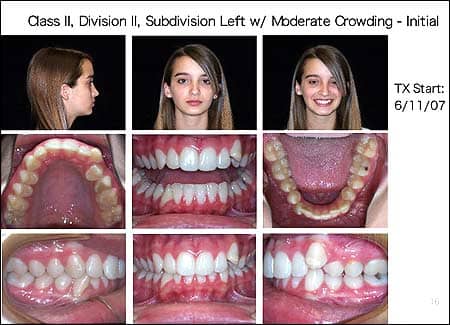 |
| Figure 5A: Dr Iwei Huang’s initial photos. He elected to treat his patient with the extraction of an upper left 2nd bicuspid, which had a large composite restoration. |
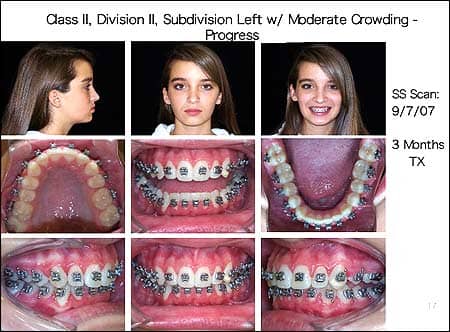 |
| Figure 5B: Progress photos the day of her i-CAT scan for SureSmile. |
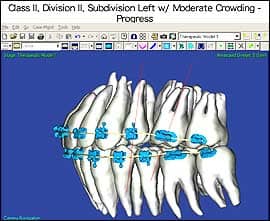 |
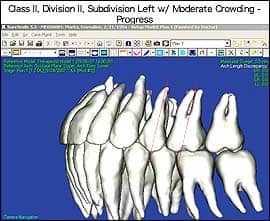 |
| Figure 5C: The SureSmile CAD models illustrate divergence of the roots for her UR4 and UR6 due to closure of the extraction site of her UR5. | Figure 5D: The SureSmile CAD treatment plan setup illustrates root parallelism of her UR4, UR6. The robotically bent prescription SureSmile Cu-Ni-Ti wires will generate the forces necessary to parallel the roots of these teeth clinically. |
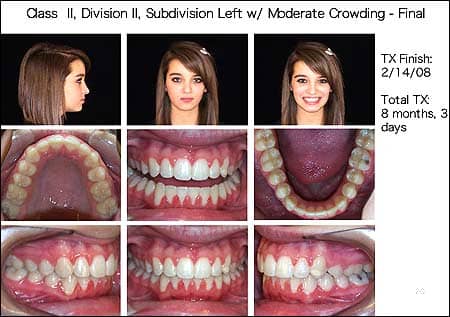 |
| Figure 5E: Final photos after 8 months and 3 days of treatment. Note the hyperplastic tissue. |
As I mentioned at the beginning of this article, I am amazed, when looking back over the past 9 years, at how quickly things have changed in our profession. With all these technological advancements, I have often contemplated, “What lies ahead for our profession?” It is my firm belief that we are gradually moving into the 3D world of therapeutic care of our patients. It will take time, but look closely at what has transpired over the past 9 years. Technologies such as Invisalign, 3D digital models, SureSmile, CBCT, Dolphin 3D, Insignia, and iBraces have all been created to offer the clinician both diagnostic and therapeutic treatment options for our patients in the 3D world. A technology such as high-volume biometric facial recognition (3DMd, Canfield Scientific Vectra 3D, Di3D) using light scanning for surface imaging is another technology that we have been evaluating. This technology is fast (about 1 second per scan) and would eliminate the need for 2D digital photographs. However, cost is a factor, and we are waiting for the costs to come down.
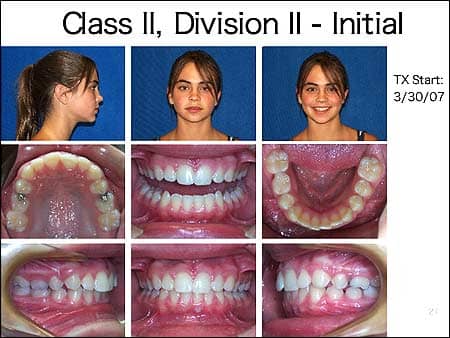 |
| Figure 6A: Initial photos for Lin’s patient. Class II correction consisted of Class II mechanics with elastic wear. |
 |
| Figure 6B: Progress photos the day of her i-CAT scan for SureSmile only 9 weeks into treatment. |
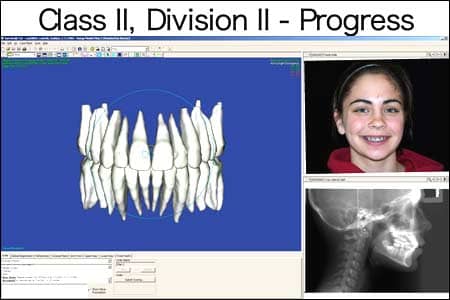 |
| Figure 6C: The SureSmile CAD treatment plan setup illustrates crown and root parallelism. |
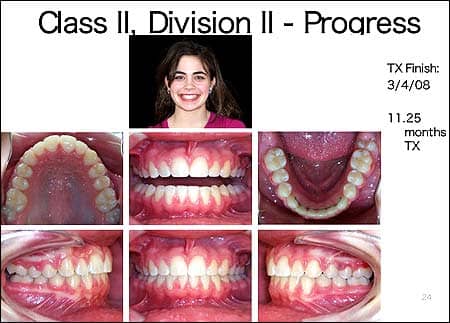 |
| Figure 6D: Final photos after 11 months and 7 days of treatment. Note the hyperplastic tissue. |
With all these changes taking place so rapidly, it is difficult to keep track of all the different technologies that are available to our profession. Challenges that lie ahead for the 21st-century orthodontist are:
- evaluation of technologies that will be able to adapt to the changes that take place in our profession and will be around for the long term;
- the cost of paying for these technologies;
- learning these technologies;
- implementation of these technologies in the private-practice setting; and
- staying current with the new updates that are implemented each and every year.
Personally, I am very excited at the thought of where technology will take orthodontics in the future. As a techie orthodontist, I love the challenges that technology presents to our orthodontic profession—and I am having a blast while doing it.
Ed Lin, DDS, MS, is a full-time practicing orthodontist and is one of four partners at Orthodontic Specialists of Green Bay (OSGB), a private group practice in Green Bay, Wis. Lin has guest lectured at Marquette University Dental School and is a nationally recognized speaker in the United States. He can be reached at



